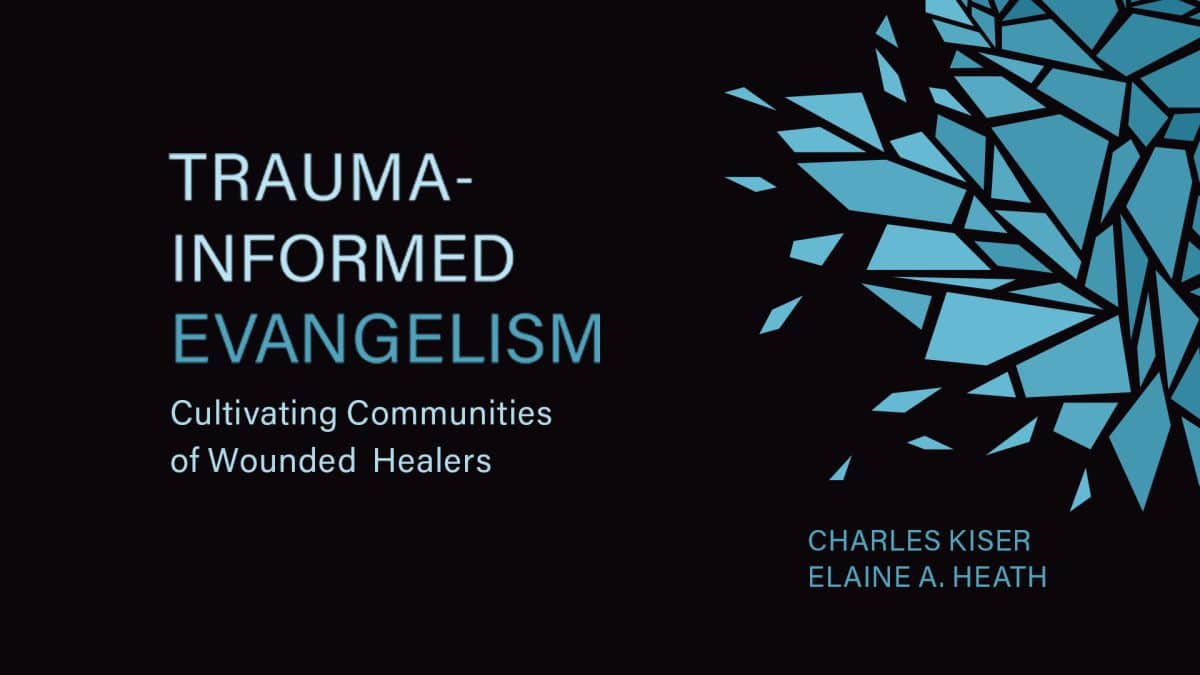

TRAUMA-INFORMED EVANGEISM: Cultivating Communities of Wounded Healers. By Charles Kiser and Elaine A. Heath. Grand Rapids, MI: Wm. B. Eerdmans Publishing Co., 2023. X + 213 pages.
We know that religious communities are experiencing declining numbers, while the number of those who claim no religious affiliation is growing quickly. Some of that growth in the nones and the dones as they are often known is due to forms of spiritual trauma. For many Christians, especially in Mainline Protestant circles, the idea of sharing one’s faith with those outside the church is considered problematic. It might appear coercive or offensive, especially for those who have had encounters with hard-sell, conversion-oriented “evangelists.” So, we keep our religious beliefs to ourselves. So, how might we overcome this evangelistic hesitancy? Are there ways of sharing our faith with others that don’t fit the stereotypes? After all, there may be folks out there, especially among the nones or dones, who might welcome an invitation to participate in a welcoming and inclusive faith community. The key to such a form of evangelism will require a great deal of vulnerability on our part.

Robert D. Cornwall
One possible approach to evangelism that is rooted in vulnerability is what Charles Kiser and Elaine Heath call Trauma-Informed Evangelism, which is the title of their recently published book. Charles Kiser is a church planter with Churches of Christ (Restoration Movement) roots and serves as the pastor of Storyline Christian Community in Dallas Texas. He holds a D.Min. in contextual theology from Northern Seminary. His co-author is Elaine Heath, a former seminary dean (Duke Divinity School) and professor of missional and pastoral theology (SMU and Duke), as well as the author of several books about evangelism. They’ve teamed up to write a very helpful book on evangelism that is appropriately titled Trauma-informed Evangelism. In this book, Kiser and Heath offer a different way of sharing faith with folks who might be open and even interested in the message of Jesus, but who have had too many traumatic encounters with Christians to make themselves vulnerable enough to hear the message. In answer to these concerns, the authors of Trauma-Informed Evangelism speak to the concerns of our day so that as we share our faith, we can bring into the conversation the realities of trauma that so many face.
The book Trauma-informed Evangelism emerged out of Kiser’s D.Min. dissertation that was undertaken under the guidance of Elaine Heath. The partnership came together when Kiser wanted to write about toxic theologies of evangelism while offering an alternative but wasn’t sure how to go about it. In answer to his question about the feasibility of the project, Heath offered to join him in writing the book. After all, she had already written about evangelism. So, the partnership was undertaken, and a book began to form that focused on the challenge of reaching out to people who have experienced spiritual trauma and abuse. The audience of this book is, first of all, church leaders and people studying for the ministry. The second audience is the community of survivors of spiritual abuse and trauma. That’s not an easy task, but they do an excellent job of bridging these two very different audiences.
Kiser and Heath divide their book into three parts. The way the chapters are assigned shows that Kiser is the lead author. Thus, Kiser provides the first three chapters in each section, while Heath wrote the fourth chapter. In Part 3, Kiser again writes the three chapters in the section, while Heath writes an epilogue that brings the book to a close. Each chapter closes with a series of discussion questions making this a book useful for reading in community. In the course of the book, Kiser uses data gathered from two groups of people. The data is based on responses to surveys and conversations that were gathered while Kiser worked on his D.Min. project. The first group of respondents is composed of members of the congregation he helped plant in Dallas, Texas, which was geared toward ministering with young professionals. The other group of respondents came out of the board game groups Kiser joined. It’s important to note that the majority of participants in the latter group were not church members. In fact, many were atheists and agnostics. Within both groups, large numbers had experienced some form of spiritual abuse or trauma. Often that had to do with the person’s sexual orientation. With the current (2023) reaction to the social/cultural gains of LGBTQ folks among a sizable group of self-described Christians, this is understandable. If you’ve been attacked by Christians because of your sexual orientation/identity it will be difficult to hear a word about the person of Jesus, some of whose self-professed followers have oppressed you. Nevertheless, it is possible to share the good news, but it requires a great deal of vulnerability to get the opportunity.
With this in mind, we turn to the first of the three sections of Trauma-informed Evangelism. Thus, Part 1, which is titled “Disordered Imagination,” focuses on matters of culture. It brings into the conversation the data culled from Kiser’s ethnographic studies. These chapters are quite revelatory, as Kiser shares stories of the pain experienced by his neighbors (chapter 1). Then there is a chapter that explores spiritual abuse and trauma (chapter 2), which is a reality that has long existed but is now being exposed in ways never before seen. That is, we are seeing increasing numbers of spiritual refugees come out of faith communities. So how is faith to be shared with them? Finally, there is a chapter dealing with “mediating narratives of supremacy” (chapter 3). Kiser points out that narratives of supremacy come in a variety of forms—racial, sexual, and religious. In her chapter in Part 1 (chapter 4), Heath offers guidance on how the wounds of Christendom might be healed. These chapters state the problem that affects people who have had abusive encounters with Christianity. As one might (or should) expect, repentance stands at the center of this response. Thus, Part 1 lays out the problem faced by those who wish to share the message of Jesus with their neighbors.
In Part Two, which the authors title “Healing Imagination,” Kiser and Heath bring theology into the conversation. In setting up this part of the conversation, Kiser notes that trauma leads to the loss of the capacity to imagine. Because they are often stuck in the eternal present they are unable to imagine a better future or experience hope, joy, or delight. Thus, “recovering the capacity to imagine is critical for healing and flourishing” (p. 73). To get there Kiser offers chapters dealing with Jesus as a trauma survivor and finding God in trauma. The latter involves theodicy. That is, coming to an understanding of God that does not involve traumatization. While the first two chapters in this section focus on trauma, the third chapter focuses on exploring restorative images of God (chapter 7). While the previous two chapters explore the way the cross and resurrection fit into the conversation, here Kiser moves beyond redemptive language to consider how to speak of God and Jesus with people who don’t need at the moment to hear a word of forgiveness for sins but seek a word of liberation from forms of oppression. Central to this message is one of solidarity on the part of Jesus with those who have experienced trauma. Finally, in her chapter, Heath writes as a theological educator, noting that seminary education is largely incapable at present to educate trauma-informed leaders. This serves as a call for the formation of leaders who can effectively minister with those who have been traumatized.
Part Three is titled “Embodied Imagination.” In the three chapters in this third section, Kiser writes about being co-witnesses with Christ, flipping hospitality, and becoming contemplative evangelists. In the chapter on being co-witnesses with Christ, Kiser speaks of three stages of recovery. This begins with “establishing safety.” Any form of “trauma-informed evangelism” must begin with building trust and safety so that stage two can be entered into. That stage involves “witnessing the story.” That is, the survivor of trauma is invited to share the story of their trauma (witnessing). Finally, with the story shared, then the final stage is entered into. That involves reconnecting to ordinary life. This likely involves becoming part of communities where survivors experience a sense of belonging. In chapter 10, titled “Flipping Hospitality,” Kiser speaks of becoming the guest. When thinking of evangelism, those who engage in it often see themselves serving as the host. But here, it will need to be flipped. This can lead to radical forms of inclusion. Kiser’s final chapter (chapter 11), is titled Contemplative Evangelists.” The focus here is on self-differentiation, such that one can become wounded healers and engage in conversation with the traumatized with compassion and empathy. Finally, in the Epilogue Heath speaks to the creation of these communities of belonging. This is the key—traumatized folks experience a need to find communities where they can belong and find healing of one’s traumas.
With so many people leaving Christian communities having been traumatized by their experience (many pastors have experienced trauma also and have left the church), this is an important and helpful word. If we are to share good news with folks who have been traumatized then we’ll need to engage in the kind of missional work incorporated here in the book by Elaine Heath and Charles Kiser aptly titled Trauma-Informed Evangelism: Cultivating Communities of Wounded Healers. The subtitle captures well the focus of this book. The word ‘evangelism’ is too often connected to hard-sell evangelistic efforts that can be coercive, manipulative, and hurtful. Engaging in something different will require the creation of faith communities that have the imagination to move forward from one’s experience of woundedness, so as to participate in God’s acts of spiritual healing. If the church is to respond positively to the needs of the moment, then pastors and church leaders need to acquaint themselves with resources such as this book by Charles Kiser and Elaine Heath. While many who have left the church due to spiritual trauma will never re-enter it, others might be open to becoming part of communities of inclusion and healing. This is a book that will help guide the creation of such communities.
This review originally appeared on BobCornwall.com.
Robert D. Cornwall is an ordained minister in the Christian Church (Disciples of Christ). Now retired from his ministry at Central Woodward Christian Church (Disciples of Christ) of Troy, Michigan, he serves as Minister-at-Large in Troy. He holds a Ph.D. in Historical Theology from Fuller Theological Seminary and is the author of numerous books including his latest “Second Thoughts about the Second Coming: Understanding the End Times, Our Future, and Christian Hope” coauthored with Ronald J. Allen. His blog Ponderings on a Faith Journey can be found at www.bobcornwall.com.






